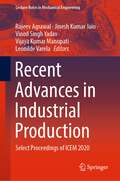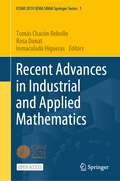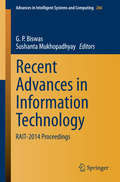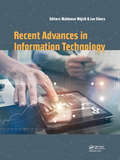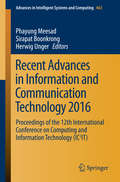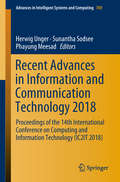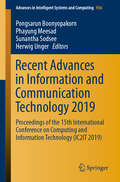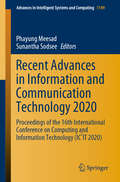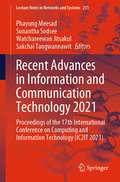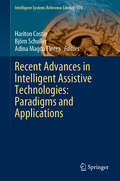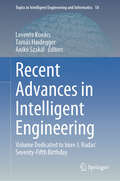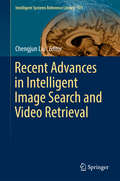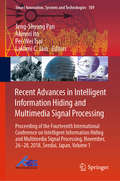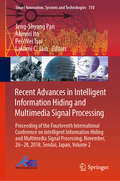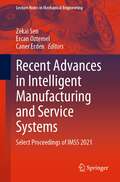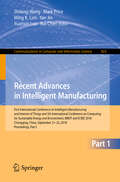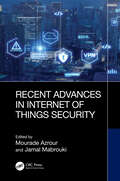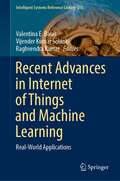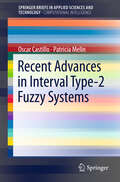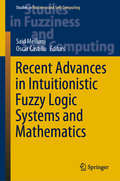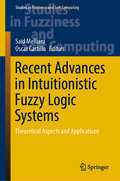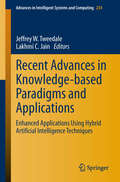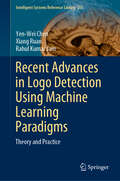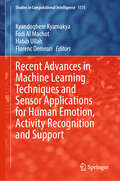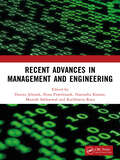- Table View
- List View
Recent Advances in Industrial Production: Select Proceedings of ICEM 2020 (Lecture Notes in Mechanical Engineering)
by Rajeev Agrawal Jinesh Kumar Jain Vinod Singh Yadav Vijaya Kumar Manupati Leonilde VarelaThis book presents the select proceedings of the International Conference on Evolution in Manufacturing (ICEM 2020), and examines a range of areas including evolution in manufacturing, intelligent networks, bio-Inspired models and algorithms, internet-of-things, and cyber manufacturing. This book intends to provide a contribution to the domain of collaborative and intelligent networks and systems to fill the gap in theories and practical applications through suitable methods and solutions applicable to a wide range of instances. Various topics covered include broad range of research challenges in the fields of artificial intelligence and addressing current and future trends in industry 4.0 oriented scenario, data analytics and big data, operation and manufacturing management. The book will be a valuable reference for beginners, researchers and professionals interested in artificial intelligence in engineering and production management and allied fields.
Recent Advances in Industrial and Applied Mathematics (SEMA SIMAI Springer Series #1)
by Inmaculada Higueras Tomás Chacón Rebollo Rosa DonatThis open access book contains review papers authored by thirteen plenary invited speakers to the 9th International Congress on Industrial and Applied Mathematics (Valencia, July 15-19, 2019). Written by top-level scientists recognized worldwide, the scientific contributions cover a wide range of cutting-edge topics of industrial and applied mathematics: mathematical modeling, industrial and environmental mathematics, mathematical biology and medicine, reduced-order modeling and cryptography. The book also includes an introductory chapter summarizing the main features of the congress. This is the first volume of a thematic series dedicated to research results presented at ICIAM 2019-Valencia Congress.
Recent Advances in Information Technology
by G. P. Biswas Sushanta MukhopadhyayThe book is based on the research papers presented in Second International Conference on Recent Advances in Information Technology (RAIT 2014), held at Indian School of Mines, Dhanbad, India. It provides the latest developments in the area of information technology and covers a variety of topics, including Advanced Algorithm Design and Analysis, Algorithmic Graph Theory, Artificial Intelligence, Bioinformatics, Circuit Design Automation, Computational Biology, Computational Mathematics, Cryptology, Data Compression, Database Management System, Data Mining, E-Applications, Embedded System, Information and Network Security, Information Retrieval, Internet Computing, etc. The objective is to familiarize the reader with the latest scientific developments that are taking place in various fields and the latest sophisticated problem solving tools that are being developed to deal with the complex and intricate problems that are otherwise difficult to solve by the usual and traditional methods.
Recent Advances in Information Technology
by Waldemar Wόjcik & Jan SikoraInformation Technology is applicable in all areas of life. As a result, computer science is essential to imagine the modern world. Recent advances in information technology represents only a small part of today’s computing applications which were the subject of international cooperation between Kazakh, Ukrainian and Polish scientists. A wide range of issues and topics is addressed, from game theory to advanced control issues: - Application of new computational models and their security problems- The integro-differential game approach - Application of information technology for automated translation, from inflected languages to sign language- Mathematical problems of complex systems investigation under uncertainties Recent advances in information technology is of interest to academics and engineers, and to professionals involved in information technology and its applications.
Recent Advances in Information and Communication Technology 2016
by Phayung Meesad Sirapat Boonkrong Herwig UngerThis proceedings book presents recent research work and results in the area of communication and information technologies. The chapters of this book contain the main, well-selected and reviewed contributions of scientists who met at the 12th International Conference on Computing and Information Technology (IC2IT) held during 7th - 8th July 2016 in Khon Kaen, Thailand The book is divided into three parts: "User Centric Data Mining and Text Processing", "Data Mining Algoritms and their Applications" and "Optimization of Complex Networks".
Recent Advances in Information and Communication Technology 2018: Proceedings of the 14th International Conference on Computing and Information Technology (IC2IT 2018) (Advances in Intelligent Systems and Computing #769)
by Phayung Meesad Herwig Unger Sunantha SodseeThis book contains the research contributions presented at the 14th International Conference on Computing and Information Technology (IC2IT 2018) organised by King Mongkut’s University of Technology North Bangkok and its partners, and held in the northern Thai city of Chiang Mai in July 2018. Traditionally, IC2IT 2018 provides a forum for exchange on the state of the art and on expected future developments in its field. Correspondingly, this book contains chapters on topics in data mining, machine learning, natural language processing, image processing, networks and security, software engineering and information technology. With them, the editors want to foster inspiring discussions among colleagues, not only during the conference. It is also intended to contribute to a deeper understanding of the underlying problems as needed to solve them in complex environments and, beneficial for this purpose, to encourage interdisciplinary cooperation.
Recent Advances in Information and Communication Technology 2019: Proceedings of the 15th International Conference on Computing and Information Technology (IC2IT 2019) (Advances in Intelligent Systems and Computing #936)
by Phayung Meesad Herwig Unger Sunantha Sodsee Pongsarun BoonyopakornThis book presents the latest research on computer recognition systems. Over the last few years, computer scientists, engineers and users have been confronted with rapid changes in computer interfaces and in the abilities of the machines and the services available. And this is just the beginning: based on recent research findings, we can expect more significant advances and challenges in the next decade. Achievements in the area of artificial intelligence have made an important major contribution to these developments: Machine learning, natural language processing, speech recognition, image and video processing are just some of the major research and engineering directions that have made autonomous driving, language assistants, automatic translation and answering systems as well as other innovative applications such as more human-oriented interfaces possible. Those developments also reflect economic changes in the world, which are increasingly dominated by the needs of enhanced globalization, international cooperation (including its competitive aspects) and emerging global problems.
Recent Advances in Information and Communication Technology 2020: Proceedings of the 16th International Conference on Computing and Information Technology (IC2IT 2020) (Advances in Intelligent Systems and Computing #1149)
by Phayung Meesad Sunantha SodseeThis book gathers the proceedings of the 16th International Conference on Computing and Information Technology (IC2IT 2020), held on May 14th–15th, 2020, at Dusit Thani Pattaya, Thailand. The topics covered include big data, artificial intelligence, machine learning, natural language processing, speech recognition, image and video processing, and deep learning. In turn, the topics represent major research and engineering directions for autonomous driving, language assistants, automatic translation, and answering systems. Lastly, they are responses to major economic changes around the world, which are increasingly shaped by the need for enhanced globalization and worldwide cooperation, and by emerging global problems.
Recent Advances in Information and Communication Technology 2021: Proceedings of the 17th International Conference on Computing and Information Technology (IC2IT 2021) (Lecture Notes in Networks and Systems #251)
by Phayung Meesad Sunantha Sodsee Watchareewan Jitsakul Sakchai TangwannawitThis book contains the proceedings of the 17th International Conference on Computing and Information Technology (IC2IT2021) that was held during May 13–14, 2021, in Bangkok, Thailand. The research contributions include machine learning, natural language processing, image processing, intelligent systems and algorithms, as well as network and cloud computing. These lead to the major research directions for emerging information technology and innovation, reflecting digital disruption in the world.
Recent Advances in Intelligent Assistive Technologies: Paradigms and Applications (Intelligent Systems Reference Library #170)
by Björn Schuller Hariton Costin Adina Magda FloreaThis book illustrates the rapid pace of development in intelligent assistive technology in recent years, and highlights some salient examples of using modern IT&C technologies to provide devices, systems and application software for persons with certain motor or cognitive disabilities. The book proposes both theoretical and practical approaches to intelligent assistive and emergent technologies used in healthcare for the elderly and patients with chronic diseases. Intelligent assistive technology (IAT) is currently being introduced and developed worldwide as an important tool for maintaining independence and high quality of life among community-living people with certain disabilities, and as a key enabler for the aging population. The book offers a valuable resource for students at technical, medical and general universities, but also for specialists working in various fields in which emergent technologies are being used to help people enjoy optimal quality of life.
Recent Advances in Intelligent Engineering: Volume Dedicated to Imre J. Rudas’ Seventy-Fifth Birthday (Topics in Intelligent Engineering and Informatics #18)
by Levente Kovács Tamás Haidegger Anikó SzakálThe book publishes new developments and advances in the various areas of computational intelligence—quickly and with a high quality. The intent is to cover the theory, applications, and design methods of computational intelligence, as embedded in the fields of engineering, computer science, physics, and life science, as well as the methodologies behind them.The book contains monographs, lecture notes, and edited volumes in computational intelligence spanning the areas of neural networks, connectionist systems, genetic algorithms, evolutionary computation, artificial intelligence, cellular automata, self-organizing systems, soft computing, fuzzy systems, and hybrid intelligent systems. Critical to both contributors and readers are the short publication time and world-wide distribution—this permits a rapid and broad disseminational of research results.Soft computing, as a collection of techniques exploiting approximation and tolerance for imprecision and uncertainty in traditionally intractable problems, has become very effective and popular especially because of the synergy derived from its components. The integration of constituent technologies provides complementary methods that allow developing flexible computing tools and solving complex problems. A wide area of natural applications of soft computing techniques consists of the control of dynamic systems, including robots. Loosely speaking, control can be understood as driving a process to attain a desired goal. Intelligent control can be seen as an extension of this concept, to include autonomous human-like interactions of a machine with the environment.Intelligent robots can be characterized by the ability to operate in an uncertain, changing environment with the help of appropriate sensing. They have the power to autonomously plan and execute motion sequences to achieve a goal specified by a human user without detailed instructions. In this book leading specialists address various theoretical and practical aspects in soft computing, intelligent robotics, and control. The problems discussed are taken from fuzzy systems, neural networks, interactive evolutionary computing, intelligent mobile robotics, and intelligent control of linear and nonlinear dynamic systems.
Recent Advances in Intelligent Image Search and Video Retrieval
by Chengjun LiuThis book initially reviews the major feature representation and extraction methods and effective learning and recognition approaches, which have broad applications in the context of intelligent image search and video retrieval. It subsequently presents novel methods, such as improved soft assignment coding, Inheritable Color Space (InCS) and the Generalized InCS framework, the sparse kernel manifold learner method, the efficient Support Vector Machine (eSVM), and the Scale-Invariant Feature Transform (SIFT) features in multiple color spaces. Lastly, the book presents clothing analysis for subject identification and retrieval, and performance evaluation methods of video analytics for traffic monitoring. Digital images and videos are proliferating at an amazing speed in the fields of science, engineering and technology, media and entertainment. With the huge accumulation of such data, keyword searches and manual annotation schemes may no longer be able to meet the practical demand for retrieving relevant content from images and videos, a challenge this book addresses. This book initially reviews the major feature representation and extraction methods and effective learning and recognition approaches, which have broad applications in the context of intelligent image search and video retrieval. It subsequently presents novel methods, such as improved soft assignment coding, Inheritable Color Space (InCS) and the Generalized InCS framework, the sparse kernel manifold learner method, the efficient Support Vector Machine (eSVM), and the Scale-Invariant Feature Transform (SIFT) features in multiple color spaces. Lastly, the book presents clothing analysis for subject identification and retrieval, and performance evaluation methods of video analytics for traffic monitoring. Digital images and videos are proliferating at an amazing speed in the fields of science, engineering and technology, media and entertainment. With the huge accumulation of such data, keyword searches and manual annotation schemes may no longer be able to meet the practical demand for retrieving relevant content from images and videos, a challenge this book addresses.
Recent Advances in Intelligent Information Hiding and Multimedia Signal Processing: Proceeding of the Fourteenth International Conference on Intelligent Information Hiding and Multimedia Signal Processing, November, 26-28, 2018, Sendai, Japan, Volume 1 (Smart Innovation, Systems and Technologies #109)
by Lakhmi C. Jain Jeng-Shyang Pan Pei-Wei Tsai Akinori ItoThis book features papers presented at IIH-MSP 2018, the 14th International Conference on Intelligent Information Hiding and Multimedia Signal Processing. The scope of IIH-MSP included information hiding and security, multimedia signal processing and networking, and bio-inspired multimedia technologies and systems. The book discusses subjects related to massive image/video compression and transmission for emerging networks, advances in speech and language processing, recent advances in information hiding and signal processing for audio and speech signals, intelligent distribution systems and applications, recent advances in security and privacy for multimodal network environments, multimedia signal processing, and machine learning. Presenting the latest research outcomes and findings, it is suitable for researchers and students who are interested in the corresponding fields. IIH-MSP 2018 was held in Sendai, Japan on 26–28 November 2018. It was hosted by Tohoku University and was co‐sponsored by the Fujian University of Technology in China, the Taiwan Association for Web Intelligence Consortium in Taiwan, and the Swinburne University of Technology in Australia, as well as the Fujian Provincial Key Laboratory of Big Data Mining and Applications (Fujian University of Technology) and the Harbin Institute of Technology Shenzhen Graduate School in China.
Recent Advances in Intelligent Information Hiding and Multimedia Signal Processing: Proceeding of the Fourteenth International Conference on Intelligent Information Hiding and Multimedia Signal Processing, November, 26-28, 2018, Sendai, Japan, Volume 2 (Smart Innovation, Systems and Technologies #110)
by Lakhmi C. Jain Jeng-Shyang Pan Pei-Wei Tsai Akinori ItoThis book features papers presented at IIH-MSP 2018, the 14th International Conference on Intelligent Information Hiding and Multimedia Signal Processing. The scope of IIH-MSP included information hiding and security, multimedia signal processing and networking, and bio-inspired multimedia technologies and systems. The book discusses subjects related to massive image/video compression and transmission for emerging networks, advances in speech and language processing, recent advances in information hiding and signal processing for audio and speech signals, intelligent distribution systems and applications, recent advances in security and privacy for multimodal network environments, multimedia signal processing, and machine learning. Presenting the latest research outcomes and findings, it is suitable for researchers and students who are interested in the corresponding fields.IIH-MSP 2018 was held in Sendai, Japan on 26–28 November 2018. It was hosted by Tohoku University and was co‐sponsored by the Fujian University of Technology in China, the Taiwan Association for Web Intelligence Consortium in Taiwan, and the Swinburne University of Technology in Australia, as well as the Fujian Provincial Key Laboratory of Big Data Mining and Applications (Fujian University of Technology) and the Harbin Institute of Technology Shenzhen Graduate School in China.
Recent Advances in Intelligent Manufacturing and Service Systems: Select Proceedings of IMSS 2021 (Lecture Notes in Mechanical Engineering)
by Zekai Sen Ercan Oztemel Caner ErdenThis book comprises the proceedings of the 11th International Symposium on Intelligent Manufacturing and Service Systems 2021. The contents of this volume focus on recent technological advances in the field of artificial intelligence in manufacturing & service systems including 3D printing, augmented reality, bioinformatics, intelligence interaction, traffic flow analytics, medical informatics, distance healthcare, robotic systems, etc. This volume will prove a valuable resource for those in academia and industry.
Recent Advances in Intelligent Manufacturing: First International Conference On Intelligent Manufacturing And Internet Of Things And 5th International Conference On Computing For Sustainable Energy And Environment, Imiot And Icsee 2018, Chongqing, China, September 21-23, 2018, Proceedings, Part I (Communications In Computer And Information Science #923)
by Mark Price Yan Jin Shilong Wang Ming K. Lim Yuanxin Luo Rui ChenThe three-volume set CCIS 923, CCIS 924, and CCIS 925 constitutes the thoroughly refereed proceedings of the First International Conference on Intelligent Manufacturing and Internet of Things, and of the 5th International Conference on Intelligent Computing for Sustainable Energy and Environment, ICSEE 2018, held in Chongqing, China, in September 2018.The 135 revised full papers presented were carefully reviewed and selected from over 385 submissions.The papers of this volume are organized in topical sections on: digital manufacturing; industrial product design; logistics, production and operation management; manufacturing material; manufacturing optimization; manufacturing process; mechanical transmission system; robotics.
Recent Advances in Internet of Things Security
by Mourade Azrour and Jamal MabroukiThe growth of the Internet of Things (IoT) technology has indeed led to an increase in cybersecurity issues. While the Internet of Things enhances accessibility, integrity, availability, scalability, confidentiality, and interoperability among devices, it also faces vulnerabilities due to its diverse attack sources and lack of standardization in security protocols. This makes Internet of Things systems particularly susceptible to cyberattacks. It is essential to ensure proper security measures are in place to protect Internet of Things devices and networks, given their critical role in modern communications and the evolving threat landscape. Always remember to verify important security information from trusted sources.Recent Advances in Internet of Things Security discusses the critical importance of robust security frameworks to protect Internet of Things ecosystems against various cyber threats. It highlights the security risks associated with Internet of Things devices and applications and presents a variety of potential solutions. It is essential to remain aware of these challenges to effectively safeguard Internet of Things systems. This book delves into the complexities of IoT security, exploring a range of vulnerabilities across different layers of the IoT architecture.The book provides a comprehensive overview of Internet of Things security, emphasizing the significance of securing Internet of Things products and applications. It serves as a foundational resource for young researchers, academics, and industry professionals keen on advanced security solutions within the Internet of Things landscape, reflecting the current state of research and ongoing challenges in this field.
Recent Advances in Internet of Things and Machine Learning: Real-World Applications (Intelligent Systems Reference Library #215)
by Raghvendra Kumar Valentina E. Balas Vijender Kumar SolankiThis book covers a domain that is significantly impacted by the growth of soft computing. Internet of Things (IoT)-related applications are gaining much attention with more and more devices which are getting connected, and they become the potential components of some smart applications. Thus, a global enthusiasm has sparked over various domains such as health, agriculture, energy, security, and retail. So, in this book, the main objective is to capture this multifaceted nature of IoT and machine learning in one single place. According to the contribution of each chapter, the book also provides a future direction for IoT and machine learning research. The objectives of this book are to identify different issues, suggest feasible solutions to those identified issues, and enable researchers and practitioners from both academia and industry to interact with each other regarding emerging technologies related to IoT and machine learning. In this book, we look for novel chapters that recommend new methodologies, recent advancement, system architectures, and other solutions to prevail over the limitations of IoT and machine learning.
Recent Advances in Interval Type-2 Fuzzy Systems
by Oscar Castillo Patricia MelinThis book reviews current state of the art methods for building intelligent systems using type-2 fuzzy logic and bio-inspired optimization techniques. Combining type-2 fuzzy logic with optimization algorithms, powerful hybrid intelligent systems have been built using the advantages that each technique offers. This book is intended to be a reference for scientists and engineers interested in applying type-2 fuzzy logic for solving problems in pattern recognition, intelligent control, intelligent manufacturing, robotics and automation. This book can also be used as a reference for graduate courses like the following: soft computing, intelligent pattern recognition, computer vision, applied artificial intelligence, and similar ones. We consider that this book can also be used to get novel ideas for new lines of re-search, or to continue the lines of research proposed by the authors.
Recent Advances in Intuitionistic Fuzzy Logic Systems and Mathematics (Studies in Fuzziness and Soft Computing #395)
by Oscar Castillo Said MellianiThis book provides an overview of the state-of-the-art in both the theory and methods of intuitionistic fuzzy logic, partial differential equations and numerical methods in informatics. Covering topics such as fuzzy intuitionistic Hilbert spaces, intuitionistic fuzzy differential equations, fuzzy intuitionistic metric spaces, and numerical methods for differential equations, it discusses applications such as fuzzy real-time scheduling, intelligent control, diagnostics and time series prediction. The book features selected contributions presented at the 6th international congress of the Moroccan Applied Mathematics Society, which took place at Sultan Moulay Slimane University Beni Mellal, Morocco, from 7 to 9 November 2019.
Recent Advances in Intuitionistic Fuzzy Logic Systems: Theoretical Aspects and Applications (Studies in Fuzziness and Soft Computing #372)
by Oscar Castillo Said MellianiThis book aims at providing an overview of state-of-the-art in both the theory and methods of intuitionistic fuzzy logic, partial differential equations and numerical methods in informatics. It covers topics such as fuzzy intuitionistic Hilbert spaces, intuitionistic fuzzy differential equations, fuzzy intuitionistic metric spaces, and numerical methods for differential equations. It reports on applications such as fuzzy real time scheduling, intelligent control, diagnostics and time series prediction. Chapters were carefully selected among contributions presented at the second edition of the International Conference on Intuitionistic Fuzzy Sets and Mathematical Science, ICIFSMAS, held on April 11-13, 2018, at Al Akhawayn University of Ifrane, in Morocco.
Recent Advances in Knowledge-based Paradigms and Applications
by Lakhmi C. Jain Jeffrey W. TweedaleThis book presents carefully selected contributions devoted to the modern perspective of AI research and innovation. This collection covers several areas of applications and motivates new research directions. The theme across all chapters combines several domains of AI research, Computational Intelligence and Machine Intelligence including an introduction to the recent research and models. Each of the subsequent chapters reveals leading edge research and innovative solution that employ AI techniques with an applied perspective. The problems include classification of spatial images, early smoke detection in outdoor space from video images, emergent segmentation from image analysis, intensity modification in images, multi-agent modeling and analysis of stress. They all are novel pieces of work and demonstrate how AI research contributes to solutions for difficult real world problems that benefit the research community, industry and society.
Recent Advances in Logo Detection Using Machine Learning Paradigms: Theory and Practice (Intelligent Systems Reference Library #255)
by Yen-Wei Chen Xiang Ruan Rahul Kumar JainThis book presents the current trends in deep learning-based object detection framework with a focus on logo detection tasks. It introduces a variety of approaches, including attention mechanisms and domain adaptation for logo detection, and describes recent advancement in object detection frameworks using deep learning. We offer solutions to the major problems such as the lack of training data and the domain-shift issues. This book provides numerous ways that deep learners can use for logo recognition, including: Deep learning-based end-to-end trainable architecture for logo detection Weakly supervised logo recognition approach using attention mechanisms Anchor-free logo detection framework combining attention mechanisms to precisely locate logos in the real-world images Unsupervised logo detection that takes into account domain-shift issues from synthetic to real-world images Approach for logo detection modeling domain adaption task in the context of weakly supervised learning to overcome the lack of object-level annotation problem. The merit of our logo recognition technique is demonstrated using experiments, performance evaluation, and feature distribution analysis utilizing different deep learning frameworks. The book is directed to professors, researchers, practitioners in the field of engineering, computer science, and related fields as well as anyone interested in using deep learning techniques and applications in logo and various object detection tasks.
Recent Advances in Machine Learning Techniques and Sensor Applications for Human Emotion, Activity Recognition and Support (Studies in Computational Intelligence #1175)
by Kyandoghere Kyamakya Fadi Al Machot Habib Ullah Florenc DemroziThis book explores integrating machine learning techniques and sensor applications for human emotion and activity recognition, creating personalized and effective support systems. It covers state-of-the-art machine learning techniques and large language models using multimodal sensors. Enhancing the quality of life for individuals with special needs, particularly the elderly, is a key focus in Active and Assisted Living (AAL) research. Unlike other literature, it emphasizes support mechanisms along with recognition, using metamodel integration for adaptable AAL systems. This book offers insights into technologies transforming AAL for researchers, students, and practitioners. It is a valuable resource for developing responsive and personalized support systems that enhance life quality in smart environments. It is also essential for advancing the understanding of machine learning and sensor technologies in AAL and emotion recognition.
Recent Advances in Management and Engineering: Proceedings ofRecent Advances in Management and Engineering
by Narendra KumarIt is with great pleasure that I present to you the proceedings of our Recent Advances in Management and Engineering held on November 24 – 27, 2023 in Male. Maldives. This conference represents a milestone in our ongoing journey towards academic excellence where we aspire to become a renowned platform for the exchange of ideas, collaboration, networking, and learning. These proceedings contain contributions that are very amazing in innovations in management. It covers a wide range of issues, ranging from the most recent trends in business to innovations in fundamentals of management. A broad collection of scholars, practitioners, and thought leaders from four continents across the world worked together to produce these results, which are a reflection of their combined efforts.
